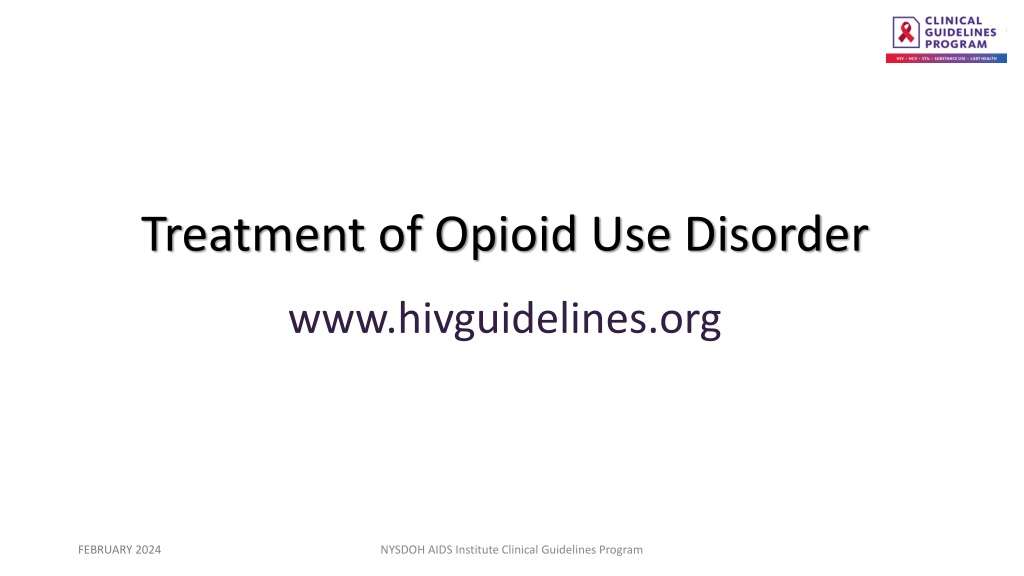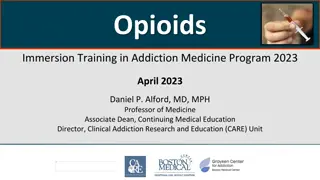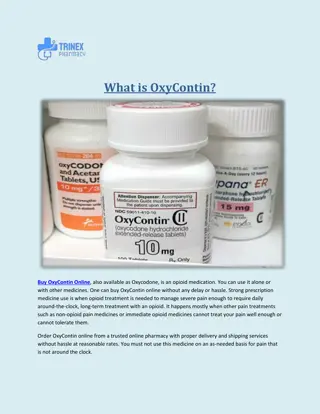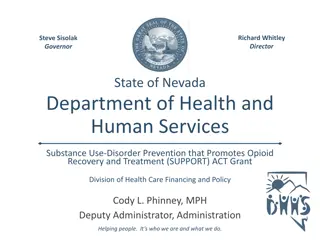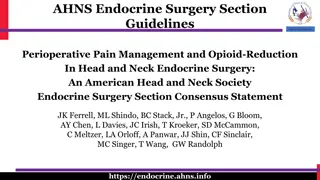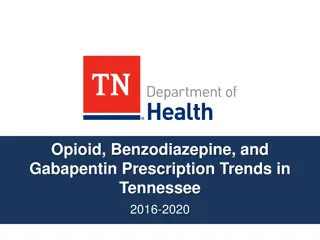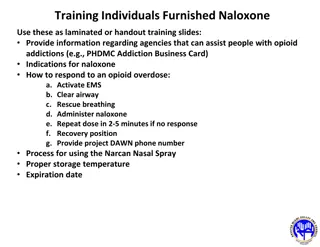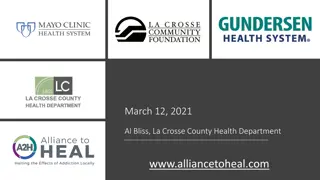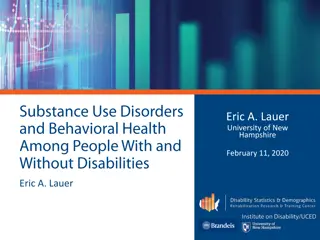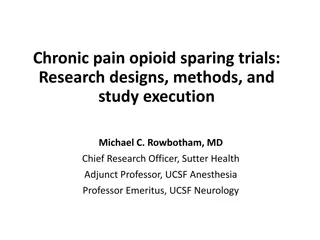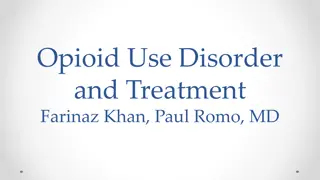Opioid Use Disorder Treatment Guidelines 2024
The February 2024 NYSDOH AIDS Institute Clinical Guidelines Program focuses on assisting clinicians in engaging with patients about opioid use disorder (OUD) treatment goals, emphasizing overdose prevention, providing updated information on available treatment options, and offering recommendations for using Buprenorphine/Naloxone (BUP/NLX) in non-specialty settings. The guidelines stress the importance of harm reduction strategies, offer recommendations for overdose prevention counseling and pharmacologic treatment for adult patients with OUD, and advocate for a patient-centered approach in choosing the best treatment option. Clinicians are encouraged to consider patients' treatment histories and engage in shared decision-making to determine the most suitable long-term pharmacologic treatment for OUD.
Download Presentation

Please find below an Image/Link to download the presentation.
The content on the website is provided AS IS for your information and personal use only. It may not be sold, licensed, or shared on other websites without obtaining consent from the author.If you encounter any issues during the download, it is possible that the publisher has removed the file from their server.
You are allowed to download the files provided on this website for personal or commercial use, subject to the condition that they are used lawfully. All files are the property of their respective owners.
The content on the website is provided AS IS for your information and personal use only. It may not be sold, licensed, or shared on other websites without obtaining consent from the author.
E N D
Presentation Transcript
Treatment of Opioid Use Disorder www.hivguidelines.org FEBRUARY 2024 NYSDOH AIDS Institute Clinical Guidelines Program
Purpose of the Guideline Purpose of the Guideline Assist clinicians in engaging with patients about OUD treatment goals, including overdose prevention. Provide up-to-date information about available OUD treatment options and their use. Provide clinical recommendations for the use of BUP/NLX to treat OUD in the nonspecialty setting. Increase the availability of nonspecialty treatment for adults with OUD. Promote a harm reduction approach to the treatment of all SUDs, which involves practical strategies and ideas for reducing the negative consequences associated with substance use. FEBRUARY 2024 NYSDOH AIDS Institute Clinical Guidelines Program www.hivguidelines.org
Recommendations: Treatment Considerations Recommendations: Treatment Considerations Overdose Prevention Clinicians should provide overdose prevention counseling (A3); prescribe, dispense, or offer resources for NLX (A2); and dispense or offer resources for fentanyl and xylazine test strips (if available) (A3) as part of OUD treatment evaluation. Who to Treat Clinicians should offer pharmacologic treatment to adult patients with OUD (A1), including those who are not actively using opioids but are at risk of returning to use or overdose. (B3) Clinicians should not exclude patients from pharmacologic OUD treatment because of: Previous OUD treatment failure, which is defined as the inability to adhere to medications for OUD or achieve treatment goals. (A3) Lack of participation in structured psychosocial treatment, such as counseling, cognitive behavioral therapy, or contingency management. (A1) If a patient is court-ordered to participate in psychosocial therapy, the clinician s primary responsibility is to maintain the therapeutic alliance and partner with the patient to address legal mandates. Co-occurring substance use or SUD. (A2) Before discharging a patient treated for an opioid-related overdose or complication, and as medically indicated, clinicians in an ED or other acute care setting should initiate or recommend pharmacologic OUD treatment. (A1) FEBRUARY 2024 NYSDOH AIDS Institute Clinical Guidelines Program www.hivguidelines.org
Recommendations: Treatment Considerations Recommendations: Treatment Considerations continued continued Treatment Options Clinicians should obtain complete histories of patients previous OUD treatment, including tolerance of and success with medication initiation, experience with long-term treatment, adherence challenges, adverse effects, treatment duration, and reasons for stopping treatment. (A2) BUP/NLX and methadone are the preferred treatments for OUD. Clinicians should inform patients with OUD about all available pharmacologic options (BUP, methadone, and XR naltrexone) and all formulations. (A3) Because OUD is a chronic condition, clinicians should recommend long-term pharmacologic treatment rather than withdrawal management alone. (A1) In choosing the best option for OUD treatment, clinicians should engage patients in shared decision-making that accounts for the patient s opioid tolerance and preferences, available and accessible options, and comorbidities. (A3) FEBRUARY 2024 NYSDOH AIDS Institute Clinical Guidelines Program www.hivguidelines.org
Key Points Key Points Harm reduction is a treatment goal. Provide overdose prevention counseling; prescribe, dispense, or offer resources for NLX; and dispense or offer resources for fentanyl and xylazine test strips as part of OUD treatment evaluation. Counsel patients to: Assume all illicitly manufactured opioids will contain fentanyl or other high-potency synthetic opioids, and that stimulants and counterfeit pills may contain these agents. When possible, test drugs with fentanyl test strips, xylazine test strips, or other drug-checking equipment. Online sources include MATTERS (for NYS residents and programs, no charge), DanceSafe, and BTNX. Some NYS Authorized Syringe Exchange Sites may provide fentanyl test strips and other drug- checking systems. Try not to use drugs alone. Arrange for someone to check in; use phone- and web-based apps (e.g., Never Use Alone Inc. at 800-484-3731). When using any drug, start with a small amount. Carry NLX, learn how to use it, and encourage friends and contacts to do the same. The 4 mg NLX nasal spray formulation is available at pharmacies, at NYSDOH-Registered Opioid Overdose Prevention Programs (no charge), or online through MATTERS (for NYS programs and residents, no charge) and NEXT Distro). NLX is covered by New York State Medicaid and the majority of private insurers. FEBRUARY 2024 NYSDOH AIDS Institute Clinical Guidelines Program www.hivguidelines.org
Recommendations: Buprenorphine/Naloxone Recommendations: Buprenorphine/Naloxone Clinicians should recommend coformulated BUP/NLX as a preferred treatment for individuals with OUD. (A1) Initiation setting: Because both home-based (unobserved) initiation and office-based (observed) initiation are effective, clinicians should advise an initiation setting based on patients experience, comfort, and preferences and clinicians practice experience and support. (B2) Precipitated withdrawal: Clinicians should assess the potential for, educate patients about, and have a clear protocol for managing precipitated withdrawal. (A3) Standard initiation: To minimize the risk of precipitated withdrawal, clinicians should advise patients to wait for the onset of mild to moderate opioid withdrawal before starting BUP/NLX treatment. (A2) As indicated, clinicians should provide adjunctive medications to relieve specific symptoms of acute opioid withdrawal. (B2) Low-dose BUP with opioid initiation (LDB-OC, previously known as microdosing or micro-induction): For patients who may be unable to tolerate opioid withdrawal before starting BUP/NLX, or for patients who have had prior experience with precipitated withdrawal with standard initiation, clinicians should offer LDB-OC as an alternative initiation approach. (A2) FEBRUARY 2024 NYSDOH AIDS Institute Clinical Guidelines Program www.hivguidelines.org
Recommendations: Buprenorphine/Naloxone Recommendations: Buprenorphine/Naloxone continued continued Clinicians should titrate BUP/NLX to the dose needed to control patients cravings, reduce or prevent withdrawal symptoms, and support treatment goals. (A3) If a patient has continued symptoms of opioid withdrawal, cravings, or opioid use despite the maximum dose of BUP/NLX approved by the FDA (24 mg/6 mg daily), the clinician should pursue 1 or more of the following strategies: Ensure the patient is taking the medication as prescribed. (A3) Increase the total daily dose of BUP up to 32 mg, particularly for patients with chronic fentanyl exposure, and reassess the need for higher (>24 mg daily) long-term dosing when patients have stabilized. (A2) Offer adjunctive medication and psychosocial treatment to relieve specific symptoms that persist after acute opioid withdrawal, known as protracted withdrawal or post-acute withdrawal syndrome. (B3) Offer long-acting injectable BUP. (A2) Offer referral to methadone treatment, if available and preferred by the patient. (A3) If a patient chooses to discontinue BUP/NLX treatment, the clinician should: Discuss alternative medication, including methadone and naltrexone. (A1) Inform the patient about the risks of recurrence of use, reduced tolerance, and opioid overdose. (A3) Offer the patient a slow, tapering decrease schedule to minimize withdrawal symptoms. (B3) Clinicians should consult with or refer the patient to a clinician experienced in treatment of SUD if encountering challenges with BUP/NLX dosing (e.g., increases beyond the FDA-approved maximum dose), switching to long-acting injectable BUP, or tapering or discontinuing treatment. (A3) FEBRUARY 2024 NYSDOH AIDS Institute Clinical Guidelines Program www.hivguidelines.org
Key Points Key Points Clinicians can contact expert consultants in OUD treatment through the following: CEI Line: 866-637-2342 Providers Clinical Support System The NYSDOH Prescription Monitoring Program Registry must be consulted before providing each prescription for BUP/NLX. The database tracks individuals history of pharmacy-dispensed controlled substances, but it does not include medications dispensed in opioid treatment programs. FEBRUARY 2024 NYSDOH AIDS Institute Clinical Guidelines Program www.hivguidelines.org
Adjunctive Medications to Relieve Acute Opioid Withdrawal Symptoms Adjunctive Medications to Relieve Acute Opioid Withdrawal Symptoms Withdrawal Symptom Medication/Class Preferred Route/Dosage/Considerations Oral, 0.1 to 0.3 mg 4 times daily Monitor blood pressure and heart rate after initial dose and before up-titration Not FDA-approved for opioid withdrawal management Autonomic hyperactivity, including muscle twitching, hot flushes or chills, restlessness Clonidine ( -2 agonist) Oral, 0.54 mg 4 times daily FDA-approved for opioid withdrawal management; costly Lofexidine ( -2 agonist) Oral, 4 mg followed by 2 mg as needed for each loose stool (up to 16 mg daily) Ensure adequate oral hydration Diarrhea Loperamide (peripheral opioid agonist) Oral, 25 to 100 mg once daily at night Insomnia Trazodone (sedating anti-depressant) Oral, 10 to 50 mg once daily at night Doxepin (sedating anti-depressant) Oral, 400 to 600 mg at least every 6 hours Avoid use in patients with severe kidney disease and decompensated cirrhosis Muscle aches, joint pain, headache Ibuprofen (NSAID) Oral, 650 to 1,000 mg at least every 6 hours Use with caution in liver disease Acetaminophen (aniline analgesic) Oral, 25 to 50 mg at least every 4 hours Can help with nausea Can be used during pregnancy Anxiety, restlessness Diphenhydramine (antihistamine) Oral, 25 to 100 mg at least every 6 hours Can help with lacrimation and rhinorrhea Hydroxyzine (antihistamine) FEBRUARY 2024 NYSDOH AIDS Institute Clinical Guidelines Program www.hivguidelines.org
Buprenorphine/Naloxone: Standard Initiation Buprenorphine/Naloxone: Standard Initiation Formulation and Mechanism of Action Dosing (individualize as indicated) Considerations for Use BUP/NLX sublingual film and tablet (multiple brands) Standard initiation: Initial BUP dose: 2 mg to 8 mg once patient is experiencing mild to moderate opioid withdrawal Titration: Increase BUP dose every 1 to 2 hours by increments of 2 mg to 4 mg over 2 to 7 days until opioid cravings and withdrawal symptoms are controlled. Long-term treatment: The maximum dose of BUP is typically 24 mg taken once daily. Increasing the dose up to 32 mg daily may be indicated for individuals with ongoing withdrawal, cravings, or opioid use. The individualized dose that is most effective in supporting treatment goals should be continued as long-term treatment. The total BUP dose can be divided by 2 or 3 for dosing throughout the day per patient preference. Standard initiation: Confirm opioid withdrawal symptoms and severity by observation or patient report before starting BUP/NLX. Ensure that the patient understands the dosing schedule and how to take BUP/NLX: avoid swallowing and let the medication dissolve under the tongue. Maximum dose: If a patient has opioid withdrawal symptoms or cravings that are not controlled by the FDA-approved BUP maximum dose of 24 mg daily, dosing up to 32 mg daily may be beneficial but may require insurance prior authorization. In New York, as of January 18, 2024, the state Medicaid program covers up to 32 mg BUP daily for OUD treatment without prior authorization. Mechanism: Partial opioid agonist FEBRUARY 2024 NYSDOH AIDS Institute Clinical Guidelines Program www.hivguidelines.org
Buprenorphine/Naloxone: Low Buprenorphine/Naloxone: Low- -Dose Initiation Opioid Continuation Opioid Continuation Dose Initiation With With Formulation and Mechanism of Action Dosing (individualize as indicated) Considerations for Use BUP/NLX sublingual film and tablet (multiple brands) LDB-OC (previously known as microdosing or micro- induction): Initial BUP dose: 0.25 to 0.5 mg while patient continues taking full opioid agonist Titration: Increase with low-dose increments of BUP over 7 days to reach therapeutic level; discontinue full opioid agonist. Long-term treatment: The maximum dose of BUP is typically 24 mg taken once daily. Increasing the dose up to 32 mg daily may be indicated for individuals with ongoing withdrawal, cravings, or opioid use. The individualized dose that is most effective in supporting treatment goals should be continued as long-term treatment. The total BUP dose can be divided by 2 or 3 for dosing throughout the day per patient preference. LDB-OC: Does not require opioid withdrawal and can be an alternative for patients who may not be able to tolerate standard initiation Individualized patient protocols, pharmacy blister packing, and care coordination with close follow-up are essential to success of low-dose initiation. Expert consultation may be helpful to guide individualization and coordination of low-dose initiation. Discuss the risks of ongoing nonprescribed opioid use and strategies to maximize safe use. Ensure that the patient understands the dosing schedule, how to cut the medication into smaller doses, and to avoid swallowing and let the medication dissolve under the tongue. Maximum dose: If a patient has opioid withdrawal symptoms or cravings that are not controlled by the FDA-approved BUP maximum dose of 24 mg daily, dosing up to 32 mg daily may be beneficial but may require insurance prior authorization. In New York, as of January 18, 2024, the state Medicaid program covers up to 32 mg BUP daily for OUD treatment without prior authorization. Mechanism: Partial opioid agonist FEBRUARY 2024 NYSDOH AIDS Institute Clinical Guidelines Program www.hivguidelines.org
Example Protocol for Outpatient Low Example Protocol for Outpatient Low- -Dose With Opioid Continuation With Opioid Continuation [ [a,b Dose Buprenorphine Buprenorphine a,b] ] Day Dosing of BUP [c] Total Daily Dose of BUP Full Opioid Agonist Use/Administration 1 0.5 mg once daily 0.5 mg Continue 2 0.5 mg twice daily 1 mg Continue 3 1 mg twice daily 2 mg Continue 4 2 mg twice daily 4 mg Continue 5 3 mg twice daily 6 mg Continue 6 4 mg twice daily 8 mg Continue 7 8 mg AM and 4 mg PM 12 mg STOP a. This 7-day protocol is based on clinical review articles and the author s experience. Protocols should be individualized to the patient and can be shortened or extended in duration. Low-dose BUP with opioid continuation was previously known as microdosing or micro-induction. Low-dose initiation requires splitting the BUP/NLX 2 mg/0.5 mg films or tablets. A quarter of a film or tablet is a 0.5 mg BUP dose; half of a film or tablet is a 1 mg BUP dose. b. c. FEBRUARY 2024 NYSDOH AIDS Institute Clinical Guidelines Program www.hivguidelines.org
Buprenorphine: Alternative Formulations Buprenorphine: Alternative Formulations Formulation and Mechanism of Action Dosing (individualize as indicated) Considerations for Use See BUP/NLX dosing, previous. See BUP/NLX considerations for use, previous. BUP monotherapy sublingual tablets (multiple brands) Must be delivered from pharmacies or distributors that are certified by the manufacturer s REMS. XR-BUP subcutaneous depot injections (multiple brands) Sublocade (monthly) Oral initiation: Patients should tolerate taking sublingual BUP 8 mg per day for 7 days prior to injection initiation. Sublocade Store in refrigeration; can only be stored at room temperature for up to 12 weeks. Mechanism: Partial opioid agonist Injection initiation: Administer the first 300 mg injection at week 1, and the second 300 mg injection 4 weeks after the first. Administer subcutaneously in abdominal region. Maintenance doses can be administered up to 2 weeks late without clinically significant impact. Long-term treatment: Administer maintenance dose of 100 mg or 300 mg every 4 weeks. The monthly dose that is most effective in managing opioid cravings and supporting treatment goals should be continued as maintenance treatment. FEBRUARY 2024 NYSDOH AIDS Institute Clinical Guidelines Program www.hivguidelines.org
Buprenorphine: Alternative Formulations Buprenorphine: Alternative Formulationscontinued continued Formulation and Mechanism of Action Dosing (individualize as indicated) Considerations for Use Must be delivered from pharmacies or distributors that are certified by the manufacturer s REMS. XR-BUP subcutaneous depot injections (multiple brands) Brixadi (weekly or monthly) Oral initiation: Administer a 4 mg sublingual dose to test BUP tolerance without precipitated withdrawal. Brixadi Injection initiation: Store at room temperature. Mechanism: Partial opioid agonist For patients not already taking sublingual BUP, administer a first dose of Brixadi 16 mg followed by an additional dose of 8 mg within 3 days of the first dose for a total weekly dose of 24 mg. An additional 8 mg dose can be administered at least 24 hours after the previous injection for a total weekly dose of 32 mg. Administer subcutaneously in the abdomen, buttock, or thigh. After 4 consecutive injections in one of the sites noted above, the injection can be administered subcutaneously in the upper arm. For patients already taking sublingual BUP, administer the corresponding dose of Brixadi weekly or monthly for the initial dose. See prescribing information for dose equivalents. Long-term treatment: Dose is individualized with a maximum dose of 32 mg weekly or 128 mg monthly. FEBRUARY 2024 NYSDOH AIDS Institute Clinical Guidelines Program www.hivguidelines.org
Considerations When Choosing Buprenorphine or Considerations When Choosing Buprenorphine or Methadone (Preferred Agents for OUD Treatment) Methadone (Preferred Agents for OUD Treatment) Consideration Buprenorphine Methadone Effectiveness Treatment of OUD with BUP or methadone is associated with reducing other opioid use, promoting treatment retention, and reducing all-cause and overdose-related mortality. Patient preferences May be preferable for patients who are new to pharmacologic OUD treatment, have had previous success with BUP, do not like or want to take methadone, or who have requested this medication May be preferable for patients who have had previous success with methadone, do not like or want to take BUP, or who have requested this medication. Setting Available through various treatment settings, including office-based prescription or specialty opioid treatment programs (OTPs). Available only through a specialty OTP or a mobile medical unit (in New York State). Effective for 1 year after the end of the COVID-19 Public Health Emergency, OTPs have increased flexibility to provide unsupervised take-home doses of methadone, potentially up to 28-day supplies, depending on the patient s time in treatment and the OTP clinician s assessment of therapeutic risks and benefits. FEBRUARY 2024 NYSDOH AIDS Institute Clinical Guidelines Program www.hivguidelines.org
Considerations When Choosing Buprenorphine or Considerations When Choosing Buprenorphine or Methadone (Preferred Agents for OUD Treatment) Methadone (Preferred Agents for OUD Treatment) continued continued Consideration Buprenorphine Methadone Initiation Opioid withdrawal is required for standard initiation. Low-dose BUP with opioid continuation (previously known as microdosing or micro-induction) is an alternative strategy that does not require onset of opioid withdrawal. Opioid withdrawal is not required for initiation. Titration Sublingual doses can be increased to an FDA- approved maximum of 24 mg per day to suppress opioid cravings and prevent withdrawal. Dose can be increased gradually to suppress opioid cravings and prevent withdrawal, with no maximum dose. Sublingual dose increases up to 32 mg daily may be indicated for individuals with ongoing withdrawal symptoms, cravings, or opioid use, but clear documentation of rationale and prior insurance authorization may be required. In New York, as of January 18, 2024, the state Medicaid program covers up to 32 mg BUP daily for OUD treatment without prior authorization. FEBRUARY 2024 NYSDOH AIDS Institute Clinical Guidelines Program www.hivguidelines.org
Considerations When Choosing Buprenorphine or Considerations When Choosing Buprenorphine or Methadone (Preferred Agents for OUD Treatment) Methadone (Preferred Agents for OUD Treatment) continued continued Consideration Buprenorphine Methadone Lower risk of respiratory depression and sedation than full-agonist opioids. Higher risk of respiratory depression and sedation than partial-agonist opioids; dose with caution in patients with severe respiratory disease or who are taking methadone in combination with other sedating substances. Associated with QT prolongation, particularly with history of arrhythmia, structural heart disease, or concurrent use of other QTc prolonging medications. Opioid-related adverse effects can occur, including constipation and sleep- disordered breathing. Adverse effects and safety Opioid-related adverse effects can occur, including constipation and sleep-disordered breathing. Medication interaction Few clinically significant interactions with medications other than full opioid agonists. Clinically significant interactions with medications that are metabolized by CYP450 enzymes can occur, leading to increased or decreased effects of methadone. Specialty OTPs offer more structured counseling and support services than primary care settings. In NYS, psychosocial counseling is not required for methadone treatment. Counseling requirements Not required unless legally mandated, but clinicians can refer for behavioral therapy and support services. Can be considered when benefits outweigh risks Closely monitor switch to BUP because of the potential for precipitated withdrawal. Treatment switch Switching to XR-BUP or methadone is possible if needed to control opioid cravings and withdrawal despite maximized sublingual BUP dosing. FEBRUARY 2024 NYSDOH AIDS Institute Clinical Guidelines Program www.hivguidelines.org
Recommendations: Methadone Recommendations: Methadone Clinicians should recommend methadone as a preferred treatment for individuals with OUD. (A1) Methadone is available only through an opioid treatment program; therefore, the clinician should refer a patient for methadone treatment if methadone is preferred, if BUP/NLX is not available to the patient, or if the maximum dose of BUP/NLX does not control the patient s withdrawal symptoms or cravings. (A3) FEBRUARY 2024 NYSDOH AIDS Institute Clinical Guidelines Program www.hivguidelines.org
Recommendations: XR Naltrexone (Alternative) Recommendations: XR Naltrexone (Alternative) Clinicians should offer XR naltrexone to patients with OUD who prefer naltrexone treatment or who are not able to access or meet their treatment goals with methadone or BUP/NLX. (A3) When informing patients about XR naltrexone as a treatment option, clinicians should emphasize the strong motivation and adherence required for success. (B1) Before administering XR naltrexone, clinicians should administer an NLX (or low-dose naltrexone) challenge and confirm that patients do not react to ensure that opioids have been cleared from the system. (A2) FEBRUARY 2024 NYSDOH AIDS Institute Clinical Guidelines Program www.hivguidelines.org
XR Naltrexone (Alternative) XR Naltrexone (Alternative) Formulations and Mechanism of Action Dosing Considerations for Use Initial and long-term treatment (intragluteal injections): 380 mg every 28 days Before starting XR naltrexone, confirm appropriate washout period from last opioid use with an NLX challenge: Administer intranasal NLX as available (e.g., 4 mg/0.1 mL) and observe the patient s reaction. In individuals with recent opioid use, this may precipitate opioid withdrawal. If intranasal NLX is not available, consider use of oral naltrexone, starting with a low dose (e.g., a quarter of a 50 mg tablet). If a patient is already taking oral naltrexone, an NLX challenge is not necessary. Inform patients of risk of precipitated and protracted opioid withdrawal if opioids are used before taking naltrexone. Emphasize the strong motivation and adherence needed for treatment success. Do not initiate naltrexone in patients with concomitant use of opioid analgesics or opioid agonists (e.g., methadone or BUP) with no plans for tapering or discontinuation. XR naltrexone (Vivitrol) Mechanism: Opioid antagonist FEBRUARY 2024 NYSDOH AIDS Institute Clinical Guidelines Program www.hivguidelines.org
XR Naltrexone (Alternative) XR Naltrexone (Alternative) continued continued Formulations and Mechanism of Action Dosing Considerations for Use Initial and long-term treatment (intragluteal injections): 380 mg every 28 days Before administering the initial injection, inform patients of the potential adverse effects of naltrexone and initiate oral naltrexone. Advise the patient to: Take 25 mg of oral naltrexone (half of a 50 mg naltrexone tablet). After 1 hour, if no adverse effects are experienced, take another 25 mg of oral naltrexone (second half of the 50 mg tablet). If adverse effects are not experienced, take 50 mg of oral naltrexone once daily for 2 to 3 days. If adverse effects are experienced, stop taking oral naltrexone. Contraindications: Concomitant use of opioid analgesics or opioid agonists (e.g., methadone or BUP), current physiologic opioid dependence, acute opioid withdrawal, and failure on the NLX challenge test or a positive urine screen for opioids. Warn patients of the increased risk of opioid overdose due to increased sensitivity after discontinuing naltrexone. XR naltrexone (Vivitrol) Mechanism: Opioid antagonist FEBRUARY 2024 NYSDOH AIDS Institute Clinical Guidelines Program www.hivguidelines.org
Pain Management for Patients with OUD Pain Management for Patients with OUD Individuals with OUD often have co-occurring pain, including acute and chronic pain. In general, patients who are taking BUP or methadone for OUD treatment should continue to take their long- term treatment dose while optimizing nonopioid medications and nonpharmacologic treatments. Temporarily increasing the BUP/NLX or methadone dose or splitting the dosing frequency may be effective for managing acute pain; the addition of a short-acting full-agonist opioid can be considered for management of moderate to severe acute pain. When adding a full-agonist opioid analgesic, patients will likely need a higher dose than opioid- naive patients to achieve adequate analgesia. Consult the American Society of Addiction Medicine National Practice Guideline for the Treatment of Opioid Use Disorder: 2020 Focused Update > Special Populations: Individuals With Pain. FEBRUARY 2024 NYSDOH AIDS Institute Clinical Guidelines Program www.hivguidelines.org
Need Help? Need Help? NYSDOH AIDS Institute Clinical Guidelines Program www.hivguidelines.org
Access the Guideline Access the Guideline www.hivguidelines.org > Treatment of Opioid Use Disorder Also available: Printable pocket guide and PDF NYSDOH AIDS Institute Clinical Guidelines Program www.hivguidelines.org
